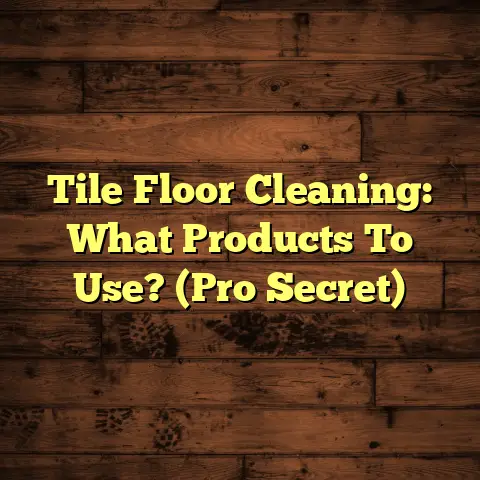Seal Shower Floor Tile? (2 Leaks to Avoid!)
Well, you’re not wrong!
Tiled showers have been a symbol of cleanliness and elegance for centuries.
From the stunning mosaics in ancient Roman baths to the sleek, modern designs we see today, tile work is an art.
But here’s the thing: All that beauty can quickly turn into a headache if you don’t protect your investment.
That’s where sealing comes in. I’m going to walk you through why sealing your shower floor tile is crucial, the risks of skipping it, and how to avoid some seriously nasty leaks.
Trust me, as a flooring contractor with years of experience, I’ve seen it all!
Let’s dive in!
The Tradition of Tiled Showers
Think about it: Why do we even have tiled showers?
It’s not just about aesthetics. Tile has been a go-to material for wet areas for ages because, when properly installed and maintained, it’s durable and water-resistant.
The Romans were masters of mosaic, creating intricate designs that not only looked amazing but also served a practical purpose in their bathhouses.
Fast forward to today, and we’re still using tile for its durability and style.
Whether it’s classic ceramic, modern porcelain, or luxurious natural stone, a well-tiled shower is a testament to craftsmanship and a cornerstone of bathroom design.
But here’s the kicker: Even the best tile job can fail without proper sealing.
1. The Importance of Sealing Shower Floor Tile
Okay, let’s get down to brass tacks. Why is sealing so important?
Well, sealing is like a superhero shield for your tile and grout. It protects them from the constant onslaught of moisture and staining that comes with daily showers.
Think of your tile as having tiny pores, like your skin. Without a sealant, water can seep into these pores and the grout lines, leading to a whole host of problems.
Now, the type of tile you have matters too.
- Ceramic and porcelain tiles are relatively water-resistant, but the grout between them is not.
- Natural stone tiles like marble, granite, and travertine are more porous and require sealing to prevent staining and water damage.
I’ve seen firsthand how quickly unsealed tiles can deteriorate.
Here are some eye-opening stats:
- According to the National Kitchen and Bath Association (NKBA), water damage is one of the most common and costly problems homeowners face in bathrooms.
- A study by the Institute of Inspection, Cleaning and Restoration Certification (IICRC) found that a significant percentage of bathroom water damage claims are related to failed grout and sealant.
So, sealing isn’t just a good idea; it’s essential for protecting your investment and avoiding costly repairs down the road.
2. Understanding the Risks of Unsealed Tiles
Alright, let’s talk about the scary stuff. What happens if you skip the sealing step?
Trust me, it’s not pretty.
Mold and Mildew Growth
First and foremost, unsealed tiles create the perfect breeding ground for mold and mildew.
These nasty critters thrive in damp, dark environments, and your shower is basically their dream home.
Mold and mildew aren’t just unsightly; they can also pose serious health risks.
Exposure to mold can trigger allergic reactions, asthma attacks, and other respiratory problems.
I’ve seen homeowners who had to rip out entire showers because of severe mold infestations caused by unsealed tiles.
It’s a messy, expensive, and completely avoidable situation!
Water Leaks and Structural Damage
But wait, there’s more! When water seeps through unsealed grout lines, it can penetrate the subfloor and even leak into adjacent spaces.
This can lead to:
- Damaged ceilings in the room below your shower.
- Rotting wood in the walls behind the shower.
- Structural damage to your home’s foundation.
I remember one case where a homeowner ignored a small leak in their shower for months.
Eventually, the water damage was so extensive that they had to replace a large section of their bathroom floor and repair the ceiling in their living room below.
The cost? Thousands of dollars and a whole lot of stress.
Personal Story:
I once worked on a home where the homeowner thought sealing was “just an upsell.” A year later, I got a call about a major leak in their downstairs living room.
Turns out, water had been seeping through the unsealed grout, rotting the subfloor, and eventually dripping through the ceiling below.
The repair bill was astronomical compared to the cost of sealing in the first place.
Anecdote Time!
I had a client who proudly showed off their brand-new, beautifully tiled shower. I asked if they had sealed it, and they replied, “Nah, the installer said it wasn’t necessary with this type of tile.”
Fast forward six months, and they called me in a panic. Their grout was stained, they had mold growing in the corners, and the tiles were starting to look dull.
They learned the hard way that sealing is always necessary, regardless of what someone might tell you.
3. Two Common Leaks to Avoid
Okay, now let’s get specific about the types of leaks you want to avoid.
These are the two most common culprits I see in my line of work:
Leak #1: Grout Line Failures
Grout is the mortar-like material that fills the gaps between your tiles.
While it’s essential for holding everything together, grout is also porous and prone to cracking and crumbling over time.
Why do grout lines fail?
- Improper sealing: This is the biggest reason. Without a sealant, grout absorbs water like a sponge, weakening its structure.
- Wear and tear: Daily use, harsh cleaning products, and temperature fluctuations can all take a toll on grout.
- Improper installation: If the grout wasn’t mixed or applied correctly, it’s more likely to crack and fail.
Best practices for sealing grout lines:
- Use a high-quality grout sealant: Look for a sealant specifically designed for shower use. Epoxy-based sealants are particularly durable and water-resistant.
- Apply sealant correctly: Follow the manufacturer’s instructions carefully. Typically, you’ll need to apply several thin coats, allowing each coat to dry completely before applying the next.
- Re-seal regularly: Depending on the type of sealant you use and the amount of use your shower gets, you’ll need to re-seal your grout lines every 1-2 years.
Pro Tip: I always recommend using a small brush to apply sealant directly to the grout lines.
This ensures that you get even coverage without getting sealant all over the tiles.
Leak #2: Tile Cracking and Displacement
Cracked or dislodged tiles are another common source of leaks.
When a tile cracks, it creates a pathway for water to seep behind the tile and into the subfloor.
And if a tile becomes dislodged, it leaves a gaping hole that water can easily penetrate.
Why do tiles crack or become dislodged?
- Poor installation: This is a big one. If the tiles weren’t properly adhered to the substrate, they’re more likely to crack or come loose.
- Impact: Dropping something heavy on the tile can cause it to crack.
- Temperature changes: Rapid temperature fluctuations can cause the tile and the substrate to expand and contract at different rates, leading to cracking.
- Substrate issues: If the subfloor isn’t solid and stable, it can cause the tiles to shift and crack.
Preventing tile cracking and displacement:
- Ensure a solid substrate: Before tiling, make sure the subfloor is level, clean, and free of any cracks or damage.
- Use a high-quality adhesive: Choose an adhesive specifically designed for shower use and follow the manufacturer’s instructions carefully.
- Inspect tiles regularly: Keep an eye out for any cracks, chips, or loose tiles. Address any issues promptly to prevent water damage.
- Seal the edges: Apply a bead of sealant along the edges of the tile where it meets the shower walls or floor. This will help prevent water from seeping behind the tile.
Real-World Example:
I once had a client who installed a beautiful new shower but didn’t properly prepare the subfloor.
Within a few months, the tiles started cracking and coming loose.
They ended up having to rip out the entire shower and start from scratch, costing them a fortune.
4. The Sealing Process – Step-by-Step Guide
Alright, let’s get practical. Here’s a step-by-step guide on how to seal your shower floor tiles like a pro:
Step 1: Preparation
- Clean the tiles and grout thoroughly: Use a scrub brush and a mild cleaner to remove any dirt, soap scum, or mildew. Rinse well and let the surface dry completely.
- Remove any loose grout: If you see any cracked or crumbling grout, use a grout saw or a utility knife to remove it.
- Repair any cracks or chips in the tile: Use a tile repair kit to fill in any cracks or chips. Let the repair material dry completely before proceeding.
Step 2: Choosing the Right Sealant
- Identify your tile type: Are your tiles ceramic, porcelain, or natural stone? The type of tile will determine the type of sealant you need.
- Choose a sealant specifically designed for shower use: Look for a sealant that is waterproof, mildew-resistant, and designed for use in wet environments.
- Consider the finish: Sealants come in a variety of finishes, including matte, gloss, and satin. Choose a finish that complements your tile.
Here’s a quick guide to sealant types:
| Sealant Type | Best For | Pros | Cons |
|---|---|---|---|
| Penetrating | Natural stone (marble, granite, travertine) | Doesn’t change the look of the stone, allows it to breathe | Less durable, needs more frequent reapplication |
| Membrane-Forming | Ceramic, porcelain, grout | Creates a waterproof barrier, more durable | Can change the look of the tile, may not be suitable for natural stone |
| Epoxy | Grout | Extremely durable, waterproof, stain-resistant | Can be difficult to apply, more expensive |
Step 3: Application Techniques
- Read the manufacturer’s instructions: This is crucial! Follow the instructions carefully to ensure proper application.
- Apply sealant evenly: Use a brush, roller, or applicator pad to apply a thin, even coat of sealant. Avoid applying too much sealant, as this can lead to a sticky or cloudy finish.
- Work in small sections: Apply sealant to a small section of the shower floor at a time, working your way across the entire surface.
- Wipe off excess sealant: Use a clean, dry cloth to wipe off any excess sealant from the tile surface.
- Apply multiple coats: Most sealants require two or three coats for optimal protection. Allow each coat to dry completely before applying the next.
Step 4: Curing Time and Maintenance
- Allow the sealant to cure completely: This typically takes 24-72 hours. Avoid using the shower during this time.
- Maintain the seal: Clean your shower regularly with a mild cleaner. Avoid using harsh chemicals or abrasive cleaners, as these can damage the sealant.
My Go-To Method:
I personally love using a small, angled brush for applying sealant to grout lines.
It gives me precise control and ensures that the sealant gets into every nook and cranny.
For larger tile surfaces, I use a foam roller for even coverage.
5. Long-Term Maintenance for Sealed Tiles
Okay, you’ve sealed your tiles. Great! But the job’s not over.
Long-term maintenance is key to keeping your shower looking its best and preventing future leaks.
Regular Cleaning
- Clean your shower regularly: At least once a week, use a mild cleaner to remove soap scum, dirt, and mildew.
- Avoid harsh chemicals: Stay away from abrasive cleaners, bleach, and ammonia-based products, as these can damage the sealant and the tile.
- Use a squeegee: After each shower, use a squeegee to remove excess water from the tile and grout. This will help prevent water stains and mildew growth.
Resealing
- Re-seal your tiles every 1-2 years: This will help maintain the integrity of the seal and prevent water damage.
- Look for signs of wear: If you notice that the grout is starting to stain or the tiles are looking dull, it’s time to reseal.
- Test the seal: Sprinkle a few drops of water on the grout lines. If the water beads up, the seal is still intact. If the water soaks in, it’s time to reseal.
Signs It’s Time to Reseal:
- Water doesn’t bead up on the grout: This is the easiest test. If water soaks in, the sealant is failing.
- Grout is discolored or stained: This indicates that water is penetrating the grout and causing discoloration.
- You see mold or mildew growth: This is a clear sign that the sealant is failing and allowing moisture to penetrate.
- The sealant is peeling or cracking: This is a visual indication that the sealant is breaking down and needs to be replaced.
Personal Tip: I always tell my clients to keep a log of when they seal their showers.
This helps them remember when it’s time to reseal and prevents them from neglecting this important maintenance task.
Maintenance Table
| Task | Frequency | Purpose |
|---|---|---|
| Daily Squeegee | After each use | Prevents water stains and mildew growth |
| Weekly Cleaning | Once a week | Removes soap scum, dirt, and mildew |
| Seal Inspection | Every 6 months | Checks for signs of wear and water penetration |
| Resealing | Every 1-2 years | Maintains the integrity of the seal and prevents water damage |
Conclusion: Preserving the Beauty and Functionality of Your Shower
So, there you have it! Sealing your shower floor tile is not just a one-time task; it’s an ongoing commitment to preserving the beauty and functionality of your shower.
By understanding the risks of unsealed tiles, following the proper sealing process, and maintaining the seal over time, you can avoid costly leaks, prevent mold and mildew growth, and enjoy your beautifully tiled shower for years to come.
Remember, tiled showers are more than just a modern convenience. They’re a tradition that spans centuries, a testament to craftsmanship and care.
By taking the time to seal and maintain your shower, you’re not just protecting your investment; you’re also honoring that tradition.
So, go ahead, grab that sealant, and give your shower the love and attention it deserves.
You’ll be glad you did!





